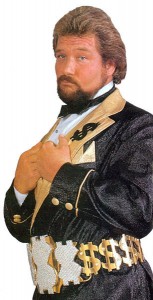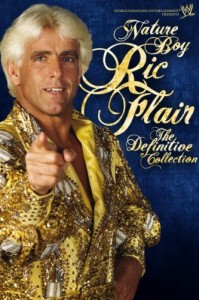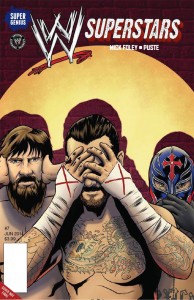 3. “MILLION DOLLAR MAN” TED DIBIASE vs. ALBERTO DEL RIO
3. “MILLION DOLLAR MAN” TED DIBIASE vs. ALBERTO DEL RIO
A second generation wrestler, Ted DiBiase would lose his father “Iron” Mike DiBiase at a young age when he suffered a heart attack in the ring. As a man, Ted DiBiase would be trained by the legendary Funk brothers (sons of the also legendary Dory Funk, Sr.) and wrestled for twelve years across the United States (including briefly in the newly founded WWF) and Japan (earning a reputation as one of the best in-ring performers in the industry) before returning to the WWF as the “Million Dollar Man.” At the time, public perception of the wealthy and money brokers was extremely negative especially in wake of “Black Monday,” where the stock market crashed due to the underhanded dealings on Wall Street and many people lost their life savings. DiBiase played this up as a heel character, using his wealth as a millionaire to see others suffer for his sole benefit which he found to be mutually amusing. Proving to be one of the best hands at cutting promos in the industry, DiBiase quickly became one of the most despised heel characters in wrestling (arguably the best in the WWF at the time). During his run, DiBiase went up against all of the WWF’s top babyfaces which included headlining two WrestleManias and the inaugural SummerSlam. After six years as the “Million Dollar Man,” DiBiase was forced to retire as a wrestler due to neck injuries and transitioned to a color commentator and manager. He went on to found the Million Dollar Corporation with some of the WWF’s top heels but the group would eventually fizzle out as DiBiase took on the debuting Ringmaster as his last client (in reality, a debuting “Stone Cold” Steve Austin). DiBiase would leave the WWF to align with the nWo in WCW before largely retiring from work in front of a camera, passing the torch to his son Ted DiBiase, Jr. who has joined the WWE.
 Son of the legendary luchador Dos Caras and nephew of the historical luchador icon Mil Máscaras (part of the original “Big Three” alongside Blue Demon and folk hero El Santo), Alberto Del Rio is a highly accomplished amateur wrestler and mixed martial artist who spent six years as one of the top talents in Mexico before making his way to the WWE. Del Rio came onto the scene as a wealthy aristocrat heel from Mexico making his debut by defeating the luchador phenom Rey Mysterio. This started a feud between the two wrestlers which spanned several months with Del Rio coming out on top. The heel went on to hire Brodus Clay as his bodyguard while Del Rio began his quest to capture championship gold. Following a number of impressive PPV victories, Del Rio accomplished his goal as the first-ever Mexican-born WWE Champion. The win turned into an ongoing three-way dance between Del Rio, John Cena, and CM Punk for a few months over the belt before the former was sidelined due to injury. Having to work his way back up the ladder again, Del Rio eventually became the World Heavyweight Champion feuding with the likes of the Big Show, Jack Swagger, Dolph Ziggler, Rob Van Dam, and John Cena. Del Rio has since returned to perform in Mexico.
Son of the legendary luchador Dos Caras and nephew of the historical luchador icon Mil Máscaras (part of the original “Big Three” alongside Blue Demon and folk hero El Santo), Alberto Del Rio is a highly accomplished amateur wrestler and mixed martial artist who spent six years as one of the top talents in Mexico before making his way to the WWE. Del Rio came onto the scene as a wealthy aristocrat heel from Mexico making his debut by defeating the luchador phenom Rey Mysterio. This started a feud between the two wrestlers which spanned several months with Del Rio coming out on top. The heel went on to hire Brodus Clay as his bodyguard while Del Rio began his quest to capture championship gold. Following a number of impressive PPV victories, Del Rio accomplished his goal as the first-ever Mexican-born WWE Champion. The win turned into an ongoing three-way dance between Del Rio, John Cena, and CM Punk for a few months over the belt before the former was sidelined due to injury. Having to work his way back up the ladder again, Del Rio eventually became the World Heavyweight Champion feuding with the likes of the Big Show, Jack Swagger, Dolph Ziggler, Rob Van Dam, and John Cena. Del Rio has since returned to perform in Mexico.
 2. “NATURE BOY” RIC FLAIR vs. CM PUNK
2. “NATURE BOY” RIC FLAIR vs. CM PUNK
One of the historical icons of the wrestling industry along with the likes of “Nature Boy” Buddy Rogers, Lou Thesz, Bruno Sammartino, Harley Race, Bob Backlund, “The American Dream” Dusty Rhodes, and Hulk Hogan, the “Nature Boy” Ric Flair became an irreplaceable fixture in Southern wrestling in the 1970s and was the face of the NWA and later WCW founding the dominant heel faction the Four Horsemen. Confidant and wealthy, Flair flaunted his prestige with tailor made suits, expensive jewelery, and the finest accommodations be it his mansion, rare cars and limousines, or private jet. A declared Don Juan with the ladies, Flair deviated from other wealthy heels down the years as while he could afford the finest things, he backed up whatever he had to say in the ring as a mutli-time champion (albeit admittedly the dirtiest player in the game). Coexisting in the same time period, many parallels have been drawn between Flair and the face of the WWF in Hulk Hogan over the years but between the two is an important distinction: Hogan was defined by the wrestlers he defeated while Flair stood atop the mountain and was the measuring stick up-and-coming talent was measured by. In other words, if someone feuded with Hogan, Hogan would almost always come out on top where a feud with Flair would often times sell whichever babyface the company wanted to promote at the time. In this way, a better comparison would be between Flair and the WWF’s phenom the Undertaker. In any event, Flair fought the best and beat the best and wouldn’t come to the WWF until 1991 (after thirteen years as the “Nature Boy”). Therein, he virtually immediately became the company’s biggest heel and challenged Hogan right away, earning the belt within the year. Flair was in the WWF for a year and a half before returning to WCW to again become their champion. He remained with the company until its closing to then return to the WWE and joined Triple H’s Evolution faction. Flair would retire as a wrestler five years later, the end of a thirty five year career, but has remained a reoccurring fixture of the WWE.
 In modern times, few have captured the intrigue of the wrestling audience as CM Punk putting him arguably in the same league as Bret “The Hitman” Hart, “The Heartbreak Kid” Shawn Michaels, Undertaker, “Stone Cold” Steve Austin, The Rock, and John Cena. A breakout megastar of Ring of Honor (the third biggest wrestling promotion in the US, behind WWE and TNA), Punk initially made his mark on the WWE as a member of the re-branded ECW (which was largely just an extension of Raw and Smackdown) as a wrestler living the straight edge lifestyle (meaning no drugs or alcohol) and went months before suffering his first defeat. The youth would go on to win the ECW Championship before being drafted into the Raw brand and within his first week captured the World Heavyweight Championship. Punk went on to the lose the belt but became the record holder for shortest amount of time between a first and third title as a Triple Crown Champion as in the months after he would capture the tag belts with Kofi Kingston and the Intercontinental Championship. While losing the belts soon after, within three months of going without gold around his waist, Punk would again obtain the World Heavyweight Championship. Punk went on to feud with the Undertaker who eventually took his belt as the former went on to found the Straight Edge Society, a cult dedicated to the straight edge lifestyle with Punk as their leader. Punk would move on to take over the Nexus (the wrestlers from the first season of NXT) but his various feuds and matches started to become routine. Despite being among the top guys in the company, Punk planned to leave the WWE when his contract was up. When given the opportunity to address the crowd honestly about his feelings about the company three weeks prior to his final appearance, Punk took the microphone and delivered what many view as the best on-air shoot (unscripted, honest commentary) in wrestling history.
In modern times, few have captured the intrigue of the wrestling audience as CM Punk putting him arguably in the same league as Bret “The Hitman” Hart, “The Heartbreak Kid” Shawn Michaels, Undertaker, “Stone Cold” Steve Austin, The Rock, and John Cena. A breakout megastar of Ring of Honor (the third biggest wrestling promotion in the US, behind WWE and TNA), Punk initially made his mark on the WWE as a member of the re-branded ECW (which was largely just an extension of Raw and Smackdown) as a wrestler living the straight edge lifestyle (meaning no drugs or alcohol) and went months before suffering his first defeat. The youth would go on to win the ECW Championship before being drafted into the Raw brand and within his first week captured the World Heavyweight Championship. Punk went on to the lose the belt but became the record holder for shortest amount of time between a first and third title as a Triple Crown Champion as in the months after he would capture the tag belts with Kofi Kingston and the Intercontinental Championship. While losing the belts soon after, within three months of going without gold around his waist, Punk would again obtain the World Heavyweight Championship. Punk went on to feud with the Undertaker who eventually took his belt as the former went on to found the Straight Edge Society, a cult dedicated to the straight edge lifestyle with Punk as their leader. Punk would move on to take over the Nexus (the wrestlers from the first season of NXT) but his various feuds and matches started to become routine. Despite being among the top guys in the company, Punk planned to leave the WWE when his contract was up. When given the opportunity to address the crowd honestly about his feelings about the company three weeks prior to his final appearance, Punk took the microphone and delivered what many view as the best on-air shoot (unscripted, honest commentary) in wrestling history.
 Called the “pipe bomb” (referring to the pipe-like appearance of the microphone and explosive things said), CM Punk spoke extensively about the politics of the WWE where nepotism was exceptionally more lauded over than talent or performance. Further, the quality of the company has slipped and will continue to slip because the management prefer yes-men to those willing to offer an honest opinion about how to improve the product. In truth, since the demise of WCW and ECW, the quality of WWF/E has gone down, its product watered-down, storylines more simplistic and frequently abandoned quickly and suddenly, air time wasted with poor mic work or aimless gags, and talent is often homogenized. Despite Punk’s microphone being shut off, his words blew up the American wrestling audience and seemingly overnight the wrestler became one of WWE’s hottest commodities. Punk decided to remain with the company and try to work from within to bring about change and along the way picked up the WWE Championship and with it the sixth longest title reign in company history. He also helped open the door for arguably the most popular wrestling trio in modern wrestling in the Shield (2/3 of the team made up of popular indie wrestlers). However, perhaps Punk’s greatest contribution was despite being one of the WWE’s biggest stars, he quit. Wracked with injuries and seeing that being a presence in the WWE could only affect so much change, he left as the company continued to keep focus on its past roster who’ve moved on and made brief returns (like the Rock and Batista) and the company began cutting the pay and roster of its undercard. By leaving, he showed that the WWE can’t continue to use the allure of fame to keep talent and invest its talent’s money to bring back wrestlers who’re making more elsewhere doing something else.
Called the “pipe bomb” (referring to the pipe-like appearance of the microphone and explosive things said), CM Punk spoke extensively about the politics of the WWE where nepotism was exceptionally more lauded over than talent or performance. Further, the quality of the company has slipped and will continue to slip because the management prefer yes-men to those willing to offer an honest opinion about how to improve the product. In truth, since the demise of WCW and ECW, the quality of WWF/E has gone down, its product watered-down, storylines more simplistic and frequently abandoned quickly and suddenly, air time wasted with poor mic work or aimless gags, and talent is often homogenized. Despite Punk’s microphone being shut off, his words blew up the American wrestling audience and seemingly overnight the wrestler became one of WWE’s hottest commodities. Punk decided to remain with the company and try to work from within to bring about change and along the way picked up the WWE Championship and with it the sixth longest title reign in company history. He also helped open the door for arguably the most popular wrestling trio in modern wrestling in the Shield (2/3 of the team made up of popular indie wrestlers). However, perhaps Punk’s greatest contribution was despite being one of the WWE’s biggest stars, he quit. Wracked with injuries and seeing that being a presence in the WWE could only affect so much change, he left as the company continued to keep focus on its past roster who’ve moved on and made brief returns (like the Rock and Batista) and the company began cutting the pay and roster of its undercard. By leaving, he showed that the WWE can’t continue to use the allure of fame to keep talent and invest its talent’s money to bring back wrestlers who’re making more elsewhere doing something else.


